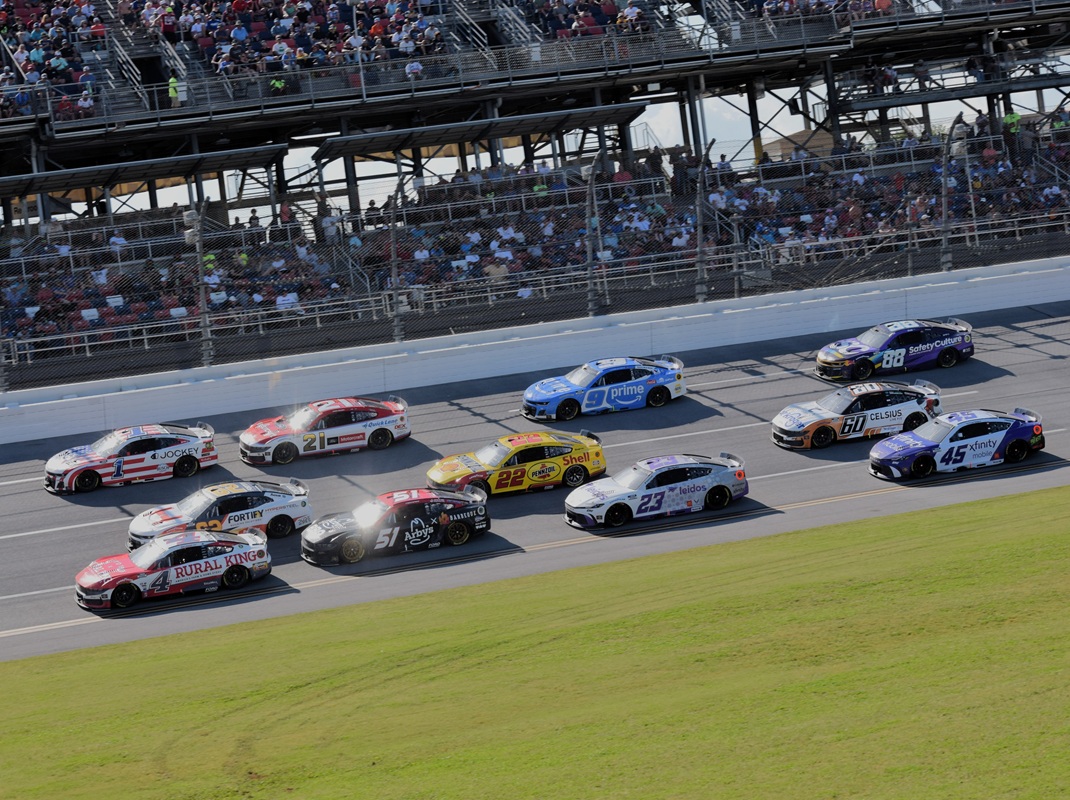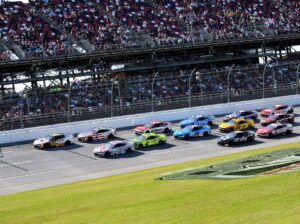OPINION: NASCAR Has Reached The Threshold Of Insanity

The NASCAR Cup Series field races in a pack Sunday at Talladega Superspeedway. (Jacob Seelman/Race Face Digital photo)
TALLADEGA, Ala. – What are we even doing here?
Rita Mae Brown’s 1983 novel Sudden Death quoted the definition of insanity as “doing the same thing over and over and expecting different results,” a phrase often attributed to Albert Einstein as well.
After Sunday’s latest display of superspeedway mediocrity in the NASCAR Cup Series, this time at Talladega Superspeedway, it’s becoming clear that we’ve reached that threshold at stock car racing’s top level.
While a first glance at the Jack Link’s 500 might have made it look like the 10th race of the Cup Series season was a competitive one – with a last-lap pass and 67 overall lead changes among 23 drivers – a more educated dive into the on-track product tells a different tale.
Yes, there were more than 19,000 green-flag passes over the 500-mile distance – 19,410 if we’re being precise – but if a “pass” for position is defined as improving one’s position from flagstand to flagstand, that’s deceiving considering that means getting a bumper ahead of the car alongside you from lap to lap counts as a pass for position.
The same can be said for the lead-change statistic. Winner Austin Cindric and Ryan Preece, who was second across the finish line Sunday before being disqualified in post-race technical inspection, officially traded the lead four times between one another over the final six laps of the race.
But go back and watch the video. Those lead changes were solely because the pair was leading their respective lines in the draft, ebbing and flowing back and forth by the time they reached start-finish, and not because one was driving up and truly passing the other in the closing laps.
It wasn’t racing as much as it was riding momentum and pushes, with everyone behind the lead duo stuck in line and unable to go anywhere, like gridlock on a major highway in bumper-to-bumper traffic (hat-tip to Chase Briscoe for that description in his post-race comments).
To me – not only a longtime race fan, but also the grandson of former NASCAR Cup Series team owners Ray and Diane DeWitt – that’s not quality racing, at least not the kind of quality I was raised on each weekend.
And yet, that’s what fans, media members, and onlookers alike are being led to believe is “good racing” these days. Comments from one high-ranking NASCAR official said as much Tuesday during ‘The Morning Drive’ on SiriusXM NASCAR Radio, channel 90.
“When you’re sitting in race control … and our fans are standing on their feet, and we’re four wide – and in some cases five wide – and everyone is cheering, and then you look at the metrics and stats after the race and you have 67 lead changes among 23 different drivers … when we look at all of that, it’s like, ‘What are we trying to fix? What’s not going the way we’d like it [to]?’” noted Elton Sawyer, NASCAR’s senior vice president of competition, to co-hosts Mike Bagley and Pete Pistone.
“I get it when we start talking about short-track packages and you have a guy leading 400-some laps of a 500-lap race, so OK, we’re going to do our best to get to work on that and figure out what we can do [to make it better] … but when you have 67 lead changes among 23 drivers, I’m not real sure what we’re going to work on there.”
I heard that and was left scratching my head and burying my face in my hands.
Fans and drivers alike have been screaming, some very loudly, in recent months that superspeedway racing has become borderline unwatchable compared to what it looked like even five to 10 years ago.
It’s not that there’s not three- and four-wide racing; it’s that it’s artificial, largely because teams have gone to fuel saving and shortening their time on pit road as the strategy to leapfrog others and gain track position, meaning that no one is truly trying to race when their focus is saving every drop of gas possible.
Longtime fans realize that, and have said as much, and yet NASCAR brass seems continually unwilling to listen based on Sawyer’s comments Tuesday that come across as somewhat tone-deaf and oblivious.
Let me lay out my prevailing thought here, and I’ve already preached it twice on social media, including once during the race Sunday: using deceiving statistics to defend a dull racing product as satisfactory is just that, deceiving.
Visual or statistical appeal does not, and will not ever, mean that the on-track product is genuine, quality racing. Quality comes down to the ability of drivers to make moves and pass others without an abundance of help or a half-second differential in lap time versus the car ahead of them (looking at you, short tracks with option tire rules).
I recognize that in the restrictor plate (or now tapered spacer) era, the draft is vital on superspeedways and that’s a fact of physics that isn’t going to change. When you look back to the racing I watched in my childhood (the mid-to-late 1990s and early 2000s), though, the ability existed for drivers to move around in the pack and slingshot to use runs and make passes, rather than being stuck like slot cars in one groove or the other.
Whether that’s because the cars of those eras had more horsepower, because of the aerodynamic rules, or because drivers felt they could make moves forward rather than being subject to dropping anchor if they pulled out of line, the fact remains that it was more compelling racing rather than visually compelling pushing.
At the end of the day, as both a media member and a fan of motorsports, I always want to see compelling racing and not something that tricks my eyes into believing that it’s compelling when it really isn’t. I’d like to think that a lot of fans feel the same way I do.
Denny Hamlin described the end of the Jack Link’s 500 as follows on his ‘Actions Detrimental’ podcast Monday: “The speeds are so fast that it’s hard to really get a third lane going at that point, anyway, and nobody is willing [to make a move] because they’ve seen what happens when you pull out of line at the end of these races … it goes nowhere.
“If you’re 18th, the last car on the outside lane, you just know that that’s where you’re going to finish that day … because it takes some sort of disturbance in the pack to really go anywhere meaningful. …
“This is what we’ve got, that once you get in line and cycle out wherever you are after that last pit stop, that most likely – without a crash – you’re going to finish within two to three positions of whatever that spot is. … Put the last two laps of the Xfinity Series race and the Cup race side by side, and tell me what’s more compelling to watch.”
It’s become evident that drivers in the Cup Series garage want the ability to really race back, instead of the kind of resignation that Hamlin described.

Anthony Alfredo (62) leads the field at Talladega Superspeedway. (Jacob Seelman/Race Face Digital photo)
Take Beard Motorsports’ Anthony Alfredo as an example, who flipped the first stage break to gain track position Sunday, but then spent much of the second stage battling hard at the front of the field and leading 19 laps before his higher fuel burn from leading hurt his strategy placement later on.
Alfredo said afterward that he was less concerned with his end result and more concerned with competing at a high level in the moment.
It was, quite honestly, refreshing to hear.
“I felt like we were good enough that I actually drug everyone along with me [in the draft] for a bit … where they were pushing harder at that point than they really wanted to,” Alfredo noted.
“I know some people are probably a bit unhappy with me for that, but I wanted to stir the pot a little bit on the fuel saving deal, because I think everyone’s kind of tired of it.”
That exhaustion is clear among the fanbase, which spoke loudly following Sawyer’s ‘Morning Drive’ appearance on social media across the board.
“There is a reason why Kyle Larson and other drivers want to race in the Xfinity and Truck Series every weekend … it’s more fun to drive those cars, just as it is to watch those cars race,” wrote user @don_mulberry.
“It’s ridiculous and frankly insulting that Sawyer thinks this smoke and mirrors show is an adequate racing product,” added user @thats_a_nas_car.
And even The Athletic’s Jeff Gluck’s “Was it a Good Race?” poll evidenced the outcry, with Sunday’s race only getting 39-percent of the vote that “Yes,” spring Talladega was indeed a good race.
It was the fourth straight Cup Series race overall to earn less than 50 percent “Yes” and the lowest-rated vote ever among Talladega races in Gluck’s poll era.
Noted journalist and content creator Taylor Kitchen said of Gluck’s poll results, “I never thought we’d see the day when Talladega got this low of a rating from the fans, but here we are. … (It’s) something to ponder as the ‘should we fix these cars’ [or] ‘how to fix these cars’ debate continues.”
And that leads to the true problem, here: NASCAR brass doesn’t seem to want to acknowledge there’s a true problem, at least, not if they’re going to continue to hide behind statistics that appear positive to say that things are in a good place.
Drivers have acknowledged openly that the proverbial toothpaste is out of the tube when it comes to superspeedway fuel saving; it’s not something that’s going to go away at this juncture. But, if that’s the case, why can’t we look at adjusting stage or race lengths to try and lessen the need for fuel saving, if we’re not going to dissect the bigger issue?
What is the bigger issue? I’ll say it, and this is coming from someone who very rarely criticizes NASCAR, unless I truly feel there’s a big issue threatening the sport at large: the Next-Gen race car.
Here’s the bottom line: we’ve tried tire compounds at certain tracks, we’ve had stage cautions, and we’ve seen minute rule changes, all in an effort to better the quality of racing at the Cup Series level.
If I’m being blatantly, openly honest in my opinion, none of it has truly worked.
The Next-Gen car was NASCAR’s baby. The sanctioning body developed it to try and lessen costs for teams and improve the on-track product, because it was more a “kit car” with spec parts, designed in theory to better both safety and parity within the sport.
If team owner comments are to be believed, the cost of racing at the top level remains an issue, even with what was supposed to be a long-term cheaper vehicle in play.
Of course, any developer doesn’t want to accept that their idea wasn’t what they hoped it would be. But I feel that NASCAR is in that boat now, and has been for a while.
The top-level product has continued to suffer. That’s a bad omen for the health of the sport.
We’ve tried every other recourse, repeatedly, to try and fix it. Nothing has worked, so why are we continuing to try the same fixes thinking that we’re suddenly going to hit on a solution or magic bullet?
Also of note here, Sawyer openly stated after Larson’s Bristol domination a few weeks ago that NASCAR is open to ideas on how to fix the product, referring at that point specifically to short tracks – another discipline that has sorely lacked from an entertainment factor recently.
It shouldn’t be up to everyone else to fix the problem. This is NASCAR’s problem. They need to step up.
It’s time to accept the reality that we need a major overhaul to get things where they need to be from a racing standpoint. It comes down to not just the car itself, but the mindset of those in charge that there needs to be change to ultimately have long-term sustainability.
If we can’t accept that, then aren’t we insane by colloquial definition?
That’s not the place I want the sport I love to be in. That’s the true bottom line.
The opinions expressed are those of the writer and do not necessarily reflect those of Race Face Brand Development, Race Face Media, their other staff members, partners, or other subsidiaries.

